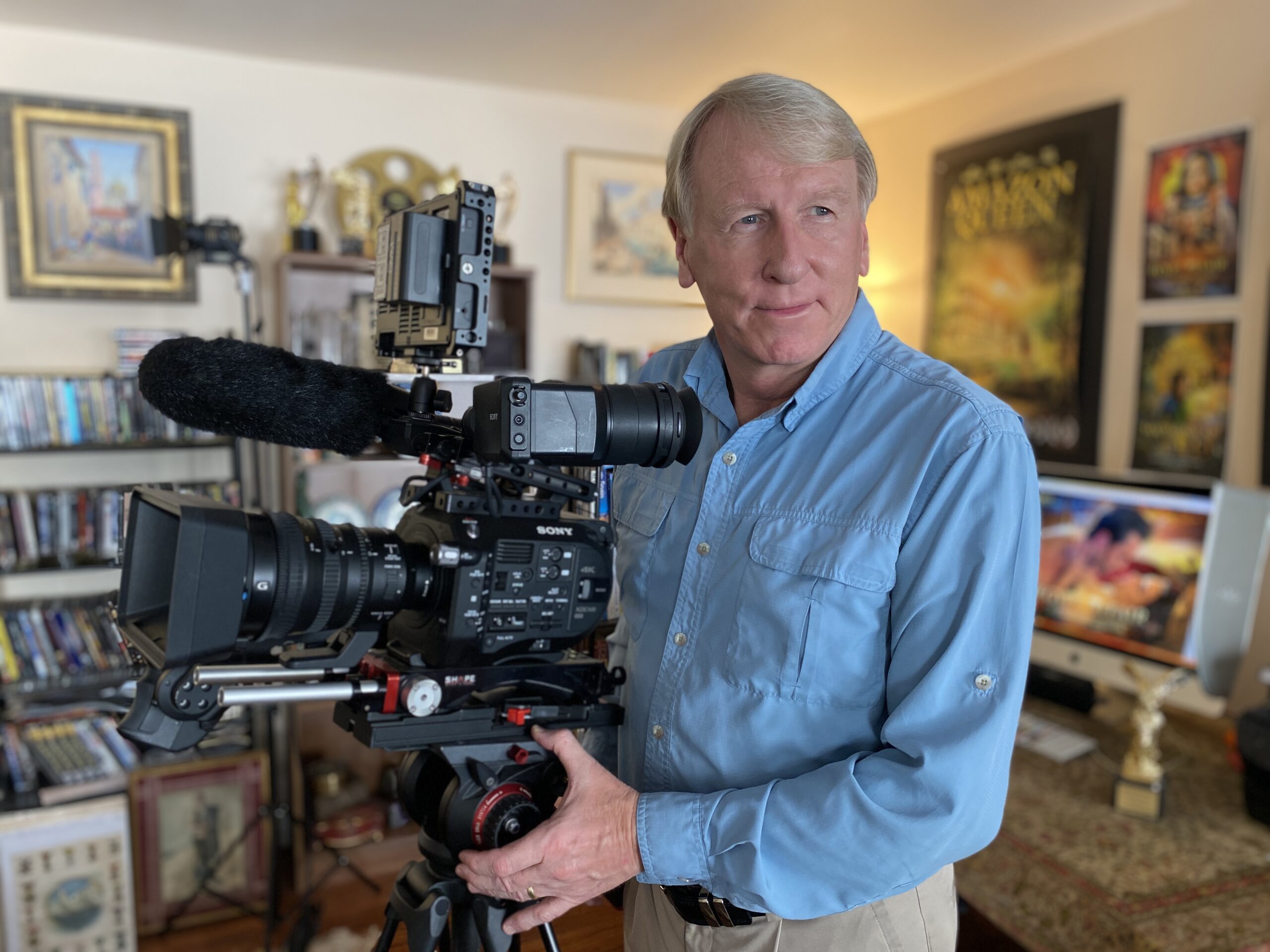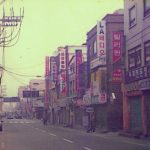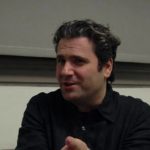Marlin Darrah is perhaps the world’s most traveled filmmaker. His 45 years of award-winning production experience have taken him to more than 140 countries worldwide, yielding more than 90 documentary, travel-adventure films, and suspense-thriller movies. He’s co-written, produced and directed three dramatic feature films – “Monsoon Wife,” “Amazon Queen” and “An Egypt Affair.” Together these movies have won 170 awards and nominations at film festivals and events in dozens of countries. Marlin’s wide variety of international film projects have been aired on programs appearing on most of the major television networks, such as the History Channel and Discovery Channel.
How did you get started traveling?
I came from a modest-of-means family in Eugene, Oregon – one that couldn’t really afford much in the way of travel, and certainly not to countries abroad. Sure, we had the family road trips now and then to the Pacific coast, to visit relatives in central Oregon, and up to Seattle. I loved it all. But I think our most exotic trip when I as young was a family car journey to Banff. My mom has never been on an airplane, and the only travel my dad experienced was as a radio officer on a ship during WW II’s Pacific Theater. A harsh kind of travel experience let’s say. It didn’t really seem that travel was in the family genes. However, I had a keen interest in collecting foreign coins, stamps and poring through National Geographic magazines and the World Book encyclopedia my folks invested in.
My first foray outside of North America was when I was 16, as I played trombone, and my high school concert band managed to spend about eight weeks touring various cities in Europe. Fantastic. That was the lodestar first travel experience, the one that cast the die for the rest of my life. I always tell audiences at my travel-film lectures that they should get their kids and grandkids to travel now, when they’re young. If you travel when young, your curiosity about the world will stay with you for the rest of your life. My daughter Maya (22) has three passports (US, Japan, and Brazil), and has already been to about 30 countries, and I know that her thirst for knowledge and world experience will be with her forever.
How did you get started as a filmmaker?
When I was 12, my dad won an 8mm camera – a booby prize at some local contest. I became fixated with that little camera, and started making short films. These were action-packed, shot-in-the-neighborhood tiny adventure stories, starring friends, like Gary Zenzen. I’d been playing piano since age 8 and I believe that background aided me in filmmaking, giving me a sense for the rhythms of editing films. Then I won an “Oregon Young Filmmaker” award and a couple of other prizes in high school, and a screening on the Oregon PBS channel, of a short I made, A Child’s Vision. There was no looking back from there. I was also a long-distance runner and Eugene, Oregon was considered the “Track Capital of the World,” back in the 1970s. You may remember such outstanding Olympic distance men as Oregon’s Steve Prefontaine and Kenny Moore. With that film’s success, I continued making films about America’s “running revolution.”
What do you consider your first “break” as a filmmaker?
I was just 20 years old when the California-based Runner’s World magazine bought my first 30-minute sports-documentary, The Marathon (the story of the three runners who qualified for the 1976 Montreal Olympics). They then hired me — at what I thought was an extraordinarily-high salary – to move to San Francisco to make more “running films.” The money was seductive, and I jumped at the opportunity. Soon, I cajoled them into sending me on assignment for a year in Europe, to ostensibly make films about big running events there, and to be poised to cover the 1980 Moscow Olympics. But as we all know, the U.S. boycotted those Olympics due to the Soviet invasion of Afghanistan. And truth be told, I was becoming bored with covering sports events and my year in Europe ended up being a blissful and possibly random exploration of a dozen countries, making little films about Swiss cheesemakers, British violin-makers, or tapestry makers in Madrid — all the while sleeping in the van or staying with other young people in their homes and apartments. I was young and I admit I easily fell in love – or lust – with many European women.
As a traveler and story gatherer/creator, what is your biggest challenge on the road?
Making travel-adventure films, documentaries, and feature films over the past many decades has given me a laser-like focus on “the project” at hand, on the specific productions I’ve been commissioned to make, or films that I’ve funded through private equity. That meticulous and obsessive focus on filmmaking is a double-edged sword however, as I’m often not able to enjoy the simpler pleasures of slow travel, not nearly as much as I would like to. But I have these achievements of making dozens of films about the world’s people and places, and they are benchmark experiences. I remember almost every day of those travels and filmmaking, as the experiences (both good and bad) are forever seared into my brain.
But the downside to making docs and movies is the limitations I have with time. As you know, nearly every minute is tightly scheduled when making movies, as a sizable amount of money is involved in the venture, and you must make the most out of every hour you have available in the country. Gone then are the leisurely afternoons with a lover at the cafes by the Seine, or the Moselle, or the Danube. Or say, shopping for fruit or fish with your local hosts at the open markets. That part of travel I do miss the most when making these international films. My wife Lin Zuo is also a producer and contributing writer on our films, and we both wish we had more time during productions to linger in the locations, and talk in more depth with the local people.
Other specific challenges I’ve had during productions. The physical challenges of getting myself, the crew and the equipment through the run of production in the swamps and forests of tribal lands in New Guinea.Sitting through dinners with cold-blooded assassins in the Tribal Zone of Pakistan, trying to bend your mind around the juxtaposition of the hospitality offered and the fact they’ve brutally killed dozens of people. Being knife-attacked in an open market by an old woman in China – never knew exactly why. And obviously, filmmaking draws a lot of attention! There have been significant challenges to film topics that might embarrass the dictates of certain strong-arm governments. I can’t tell you how many times I’ve been stopped or questioned or harassed by local authorities in communist, Muslim or dictator-driven countries.
Collectively over the years, I’ve spent several days in holding cells and prisons, trying to negotiate and bribe my way out. I’ve had the pleasure of being assaulted and nearly kidnapped by Taliban in Afghanistan. And in Madagascar – a country I love – a village witch doctor cast a dreaded curse on me for filming a zebu-sacrifice ceremony. As my camera gear is so obvious while filming on the world’s streets, it’s not so surprising I’ve been robbed often and had to chase after thieves in several countries. A few years back, my documentary team and I sat in lavish Bedouin-style desert tents with Saudi princes and expected to eat sheep eyes for appetizers. In remote areas of the world, my local hosts have generously offered appetizers consisting of various insects, bamboo worms and beetle larvae. And it can cause some offense if you didn’t chomp down a few.
What is your biggest challenge in the research, writing, and editing process?
For me, doing the background research is one of the finest pleasures of a life of travel and filmmaking. However, it’s sometimes the case I run into challenges with local people that are either afraid or embarrassed to tell me the truth behind a story I’m filming. I have to win them over sometimes by assuring them their names or images will not be used in the documentary or movie. We ran into that many times, and especially when making my movie, Monsoon Lover in Cambodia. The story was about a group of Americans that careen off the tourist path and become entangled with the horrible situation of human trafficking in that country. In our research for the story (and again in the making of the movie itself), we interviewed many young sex workers – some that had been living on the streets, or kidnapped by pimps, or as is often the case – rented out or sold by their poor village parents, to the sex houses in Phnom Penh or other cities.
The challenge was to not cause them further embarrassment or expose them in the media (or expose them in the movie upon its release), or to cause them retribution from the local authorities or the brothel owners. And regarding editing, it takes 3-4 times longer in the editing room to make the movie, compared to the actual shooting days on location. It can be a torment in the editing suite, for weeks on end, as you try to fix problems you might encounter in certain sound recordings, or when you need to find pieces of shots you really want, but that shot slides in and out of focus, for example. Editing is torture frankly, as the juice and reward for me personally is in pre-production and shooting that production on location.
What has been your biggest challenge from a business standpoint?
Making travel films and documentaries was a very good business model for me. That’s by far where I’ve made most of my money. Over four decades, I’ve been ridiculously lucky to have made at least $5 million on sales of my dozens of films. The biggest challenge I’m encountering now is making a living through the production of dramatic feature films. It’s the best of times and the worst of times. Great, everyone with a $1000 camera could be a filmmaker now, with the awesome technical improvements in gear. Anyone could in theory make “a movie” with an iPhone ProMax 14. But it’s the worst of times too since there are approximately 30,000 “movies” made each year by young people aspiring to be the next Spielberg or Scorsese or Greta Gerwig.
The market is absolutely saturated with poorly-made micro-indie films. Distributors are cruel and draconian with new filmmakers, either turning away most films, or perhaps worse, trying to shove nearly criminal contracts down their throats. It’s a despairing fact that 95% of filmmakers will never recover their budgets – never mind make a profit – from the distribution of their film. That’s incredibly sobering. A filmmaker today needs to be incredibly skilled (and hopefully possess a strong vision in their storytelling genre) and he or she also needs to be a near-genius at marketing and PR. The market is incredibly fragmented now and it comes down to the fact that filmmakers must find their niche audiences out in the world. Ideally, a filmmaker’s needs to possess an astoundingly massive social media audience that wants to watch their films, and can easily find them on the various internet platforms. That’s the biggest business challenge I face.
What travel filmmakers and authors might you recommend and/or have influenced you?
There are just so many directors that have inspired me over the years. And authors as well of course. In school, my gifted teachers plied me with the masterpieces from Fellini, Bertolucci, David Lean, Kubrick, Peter Weir, Kurosawa, Sergei Eisenstein, Truffaut, Bergman, Coppola, Ridley Scott, Hitchcock – the list is long. But regarding nature filmmakers, I look to the unique David Attenborough as an inspiration. I think Michael Moore has had an influence on me regarding docs, as has the irreplaceable Tony Bourdain, regarding travel filmmaking. For travel authors, I’m always drawn to the work of Paul Theroux – the best of them all, for me. I also enjoy the work of Pico Iyer, Chatwin and Colin Thubron. I also gravitate to the writers that have dealt so well with travel themes, like Graham Greene, Maugham, Henry Miller, Hemingway … there are so many really.
What advice and/or warnings would you give to someone who is considering going into travel filmmaking?
Generally, I advise young people not consider a life of filmmaking! The market has changed so much over the past few years, and not to the benefit of the professional travel filmmaker. Again, I point to the proliferation of inexpensive, lightweight and tech-advanced cameras as the key reason that making a living, making money from travel filmmaking, is so difficult these days. It used to be that a filmmaker had to spend at least $50,000 or more for the equipment itself. And that gear was heavy. Now with the lightweight and inexpensive cameras, there is so much competition. There are people – amateurs essentially – that take reasonably good travel videos, while simply on vacation, then post to YouTube … and all of that video content can be seen, for free.
My advice then … First ask yourself – must you really be a travel filmmaker? I would not advise it if your goal is to make a large amount of money. Are you absolutely driven and can you handle constant discouragement or turn-aways from potential clients? Do you feel you have a particular “voice” and a certain perspective on traveling that could be unique? What’s the angle on your story, who is going to really want to read your story? Don’t brag too much, don’t use the work “I” so much. Are you willing to write whitewash travel stories for airline magazines or similar — which is not true travel writing in my opinion. And as the best writers advise, try to describe the “essence” of your experience with the people, the cultures, the geography, the architecture, the fauna and flora. Be not flowery. Write descriptively – absolutely – but make it tight and telling and true.
What is the biggest reward of life as a travel filmmaker?
It’s a great privilege, and an honor really, to be a travel filmmaker or a travel writer. I try not to forget how lucky I’ve been – and how fortunate many of my professional friends have been – to be able to make a living by traveling the world. To write about it, to film it, to report on it, what a joy. For me it’s been 50 years of travel, of learning, and feeling the frisson of it all. Though we’re sickened by the dictators and the atrocities that continue around the world, we as travel filmmakers and writers realize – through personal experience – just how very beautiful the natural world still is, and we continue to realize that hospitality is the natural instinct of people far and wide.
The reward is that we have the honor of telling stories about the stunning achievements of imaginative men and women, of the inspiring architecture, the diverse cuisine and the unique and personal art that can still be found, around the globe. And I find great reward in telling the smaller stories about the humble generosity of people that welcome us into their homes.





